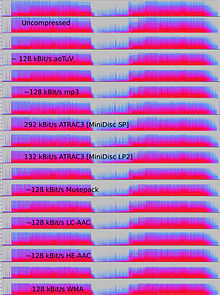Musepack
| Musepack | |
|---|---|
| Basic data
|
|
| developer | Frank Klemm & Musepack Development Team |
| Publishing year | 1997 |
| Current version | r475 (SV8) (August 10, 2011) |
| operating system | platform independent |
| category | Audio data compression |
| License | LGPLv2.1 + and BSD |
| German speaking | No |
| www.musepack.net | |
Musepack (formerly MPEGplus ) is a free , on MP2 - algorithms based codec for lossy audio data compression , which has been optimized for very good sound quality at high bit rates down.
development
Musepack was founded in 1997 by Andree Buschmann and later developed by Frank Klemm. Musepack was developed to achieve better transparency than other codecs of the time, which were intended for constant bit rates . Musepack only uses variable bit rates. When the "Musepack Development Team", still under the direction of Frank Klemm, took over the development in 2004, the source code was published and placed under the GNU Lesser General Public License .
Differences from other formats

At the time Musepack was created, the popular audio codecs (like the most popular MP3 codec) mainly used constant bit rates , which had a very negative effect on the overall sound quality. In contrast, Musepack only uses variable bit rates, whereby the bit rate can fluctuate between 3 and 1300 kbit / s. Various technical innovations such as Huffman coding and noise substitution were also introduced. Current codecs such as AAC now also support this or comparable methods.
File format
Musepack files have the filename extension mpc , mpp or mp + . Metadata is attached in the form of APEv2 tags .
Supported input formats for coding
- Channels: 1 to 8 (SV8)
- Bit depth: 1 to 32 bit linear PCM
- Sampling rates: 32 kHz, 37.8 kHz, 44.1 kHz, 48 kHz
- WAV, raw PCM data, many compressed audio formats like FLAC , LPAC , APE , OptimFROG and Shorten
advantages
- Very good sound quality, especially at bit rates from around 160–180 kbit / s. For many listeners, transparency is already achieved here.
- Very fast coding / decoding
- Relatively good software support. Supporting programs (native or through plugins) are for example: Adobe Audition (formerly Cool Edit ), VLC media player , Windows Media Player
- Gapless Playback (seamless playback of consecutive audio files)
- Free of patented processes (according to the developer)
- Free software
disadvantage
- No support for sampling rates above 48 kHz (which is not a disadvantage in practice for a music format, see Nyquist frequency )
- Good quality only at bit rates of around 100 kbit / s and more. Other formats like Vorbis and even (the technically obsolete) MP3 usually deliver better results at lower bit rates.
- Low spread
- Hardly any hardware support
future
The importance of Musepack has noticeably decreased in the past few years (as of 2007). Musepack was most widespread among very discerning music lovers who were not satisfied with the sound quality of MP3. Due to the drop in prices for mass storage devices (especially hard drives), however, loss-free compression is now being used in this area . Last but not least, the MP3 codecs have also been continuously developed and optimized; variable bit rates are now standard here. Winamp (V5.57), for example, continues to support the format (as of January 2010).
literature
- Hubert Henle: The recording studio manual. Practical introduction to professional recording technology. 5th, completely revised edition. Carstensen, Munich 2001, ISBN 3-910098-19-3 .
- Roland Enders: The home recording manual. The way to optimal recordings. 3rd, revised edition, revised by Andreas Schulz. Carstensen, Munich 2003, ISBN 3-910098-25-8 .
Web links
- Official website
- AudioHQ information page on MPC
- FreeMPC - MPC to MP3 and WAV converter, freeware for Windows 2000 or higher , Java required